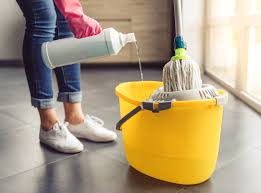What’s The Difference Between A Deep Clean
And A Regular Clean?
Are you ready to hire a professional deep
cleaning service? If so, you aren’t alone. The fact is, professional house
cleaners bring quite a few benefits to the table.
However, as you hire these services, there
are a few things you need to know. One of these things is what the difference
is between a deep clean and regular clean. Keep reading to learn all you need
to know about these two types of cleaning services.
Regular Cleaning Explained
When you hire professional house cleaners
for a “regular cleaning,” this is going to include the things you would do on a
weekly basis. A regular clean is designed to help maintain a certain level of
cleanliness around your house.
When you invest in a regular clean (which
will be what you typically receive) the home cleaner will do some of the
following things:
- Vacuuming and mopping your
floors
- Tidying up the house
- Cleaning the bathrooms –
toilet, bath, mirror, sink, etc.
- Cleaning the kitchen – wiping surfaces,
outside of appliances, taking out trash, etc.
These cleaning tasks typically don’t take
that long to complete; however, they are essential to help keep your home free
from dust, dirt and other debris.
Deep Cleaning Explained
Now that you know what a regular cleaning
entails, it’s time to discuss a deep clean. Deep cleaning is something you are
likely going to need to invest in when you first hire a cleaning service. While
deep cleaning is more expensive than regular cleaning, it also only needs to be
done every six months, or so.
A deep cleaning service will remove the
deep dirt and grime in your home. It will cover the areas that aren’t typically
covered in a regular cleaning service.
Some of the services provided when you hire
a home cleaning service for a deep clean include:
- Remove scale and soap scum from
shower heads, taps, kitchen tiles, bathroom tiles, etc.
- Clean behind appliances such as
the oven, washing machine and cut through the grime that often builds up
- Deep and complete dusting including
the baseboards and doors in all rooms
- Washing the home’s interior
windows
- Cleaning patio doors and window
frames
- Cleaning the interior of the
oven and glass door
As you can see, a deep cleaning is much
more thorough than a regular cleaning service. This is the main reason that you
pay more when you hire the professionals. It also takes longer to complete.

How to Clean Your Oven With Lemons
- Fill a medium-sized, oven-proof
mixing bowl with water. Cut two lemons in half and place them in the bowl.
- Heat your oven to 250 degrees.
- Once heated, place the mixing
bowl inside on one of the racks. Leave for one hour.
- After an hour, turn off the
oven, open the door and let it cool slightly.
- While the oven is still warm
(but cool enough that you could safely touch the inside without getting
burned), put on gloves, take a damp cloth and wipe down all surfaces, including
the back, sides, bottom, top, door, corners and crevices. If needed, use a wet
scouring pumice, microfiber sponge or other abrasive tool to target any extra
sticky spots. Be sure to wipe thoroughly so that you remove all grease and
grime.
- You’re done!

How to Clean Walls with Different Paint
Finishes
The first thing you should consider when
washing painted walls is the finish. (If needed, reference our handy guide to
paint finishes.) Whether the finish is glossy or flat will determine how
scrubbing will affect the look of the wall.
Flat, Satin, and Eggshell Finishes
Duller paint finishes are less durable when
it comes to cleaning. Do not use harsh chemicals or degreasers when cleaning
flat paint walls. When washing with a sponge, be sure not to scrub too hard.
The sponge should be wrung out almost completely before putting it to the
walls.
Glossy or Semigloss Finishes
Because these paints are highly durable,
they’re most commonly used in high-traffic areas like the kitchen and bathroom.
It’s OK to use a mild degreaser on glossy kitchen backsplashes or vanity doors.
Although glossy and semigloss paint is durable, it will still scratch, so
always use a soft sponge when cleaning walls.

How Often Should You Deep Clean Your Home?
If it wasn’t hard enough keeping on top of
the general housekeeping chores, then you may not want to know how often you
should be deep cleaning the rest of your home.
As households become busier year-on-year,
experts believe we’re rapidly losing the fight against allergens and grime.
Kitchen
- Microwave: every week. Food
splatters and left over moisture can become a breeding ground for germs. Giving
your microwave and the turntable a thorough clean every week should remove
those otherwise missed splashes.
- Refrigerator: every month. Food
spills, leaky meat wrappers and rotting vegetables (hello salad drawer!) can
lead to serious bacterial contamination. Removing all your food and wiping down
all the shelves and drawers with an antibacterial wash shall not only prevent
bacteria spreading, but also help you keep on top of expired foods.
- Oven: If your oven starts to
smell of previously cooked food or smoke, it’s time to deep clean the oven.
In-between cleans you can use a damp rag to remove spills and splashes.
Bathroom
- Bathtubs and showers: every
week. Offering a warm and moist environment, bathtubs and showers are the
perfect breeding ground for bacteria and fungus that cause skin infections.
- Toilet: every week. Most
households can manage by wiping over the cistern, buttons and toilet seat with
an antibacterial agent; deep clean the toilet weekly with a cleaner and toilet
brush to remove stains and mineral deposits.
- Showerheads: once a year.
Removing the showerhead and soaking it in a descaling product will help remove
internal mineral build-up and return the showerhead to its former glory.
- Bathmats: every week. Like the
tub, a fabric bathmat can act like a juicy spongy breeding ground for bacteria
and fungus. Use a sanitising wash to remove any harmful bugs and try to hang
the mat in full-sun to dry.
Bedrooms
- Pillows: every quarter. You
spend about a third of your life in bed, so it makes sense to regularly cleanse
your pillows from trapped dead skin, oil, sweat, allergens, dust mites and
their eggs.
- Mattresses: every six months.
Like pillows, the mattress can soak up and trap body fluids, dead skin,
allergens, dust mites and even bed bugs in its fibres. To keep your bed
smelling sweet, get the mattress professionally steam cleaned every six months.
- Duvets and blankets: every six
months. Check if your local launderette offers extra large washing machines
that are perfectly sized for large duvets and blankets.
How to Clean Walls with Latex Paint
The best way to wash walls painted with
latex paint is to use warm water and a nonabrasive all-purpose cleaner. Dip a
clean sponge in the water, then wring it dry. Gently rub the wall. Pay special
attention to areas that get touched often, such as around doorknobs and light
switches. Rinse with a second sponge and clear water. Take care not to wet
areas around outlets, light switches, telephone jacks, and other electrical
connections. If scrubbing those spots is necessary, turn off electricity at the
circuit breaker box.
For stubborn spots, such as fingerprints,
newspaper smudges, or scuffs, make a paste of baking soda and water and rub the
area with a nonabrasive pad. If cleaner (or white vinegar and water) doesn’t
remove the grime or stain on painted woodwork, wipe the woodwork with a rag
dampened with rubbing alcohol.